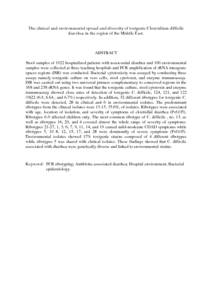Citation
N., Sadeghifard and M.H., Salari and R., Ranjbar and S., Ghafouryan and M., Raftari and Abdulamir, Ahmed Sahib and Abu Bakar, Fatimah and B., Kazemi
(2010)
The clinical and environmental spread and diversity of toxigenic Clostridium difficile diarrhea in the region of the Middle East.
Reviews in Infection, 1 (4).
pp. 180-187.
ISSN 1837-6746
Abstract
Stool samples of 1822 hospitalized patients with nosocomial diarrhea and 100 environmental samples were collected at three teaching
hospitals and PCR amplification of rRNA intergenic spacer regions (ISR) was conducted. Bacterial cytotoxicity was assayed by
conducting three assays namely toxigenic culture on vero cells, stool cytotoxin, and enzyme immunoassay. ISR was carried out using two
universal primers complementary to conserved regions in the 16S and 23S rRNA genes. It was found that the toxigenic culture, stool
cytotoxin and enzyme immunoassay showed close rates of detection of toxigenic C. difficile, 124, 121, and 122 /1822 (6.8, 6.64., and
6.7%) respectively. In addition, 32 different ribotypes for toxigenic C. difficile were detected, 28 in clinical and 6 in environmental
isolates. The predominant ribotypes from the clinical isolates were 13-15, 35.6%, of isolates. Ribotypes were associated with age, location
of isolation, and severity of symptoms of clostridial diarrhea (P<0.05). Ribotypes 6-9 affected children only. The most common ribotype
of C. difficile , no. 13, as well as ribotypes 16, 20, and 4 covered almost the whole range of severity of symptoms. Ribotypes 21-27, 1, 3,
6, 7, 9, 11, 14, and 19 caused mild-moderate CDAD symptoms while ribotypes 5, 10 8, 12, 15, 17, and 28 were dominantly of severe
symptoms (P<0.05). Environmental isolates showed 17% toxigenic strains composed of 4 different ribotypes while ribotypes 5 was
shared with clinical isolates. These findings showed that C. difficile associated with diarrhea were genetically diverse and linked to
environmental strains.
Download File
![[img]](http://psasir.upm.edu.my/17035/1.hassmallThumbnailVersion/The%20clinical%20and%20environmental%20spread%20and%20diversity%20of%20toxigenic%20Clostridium%20difficile%20diarrhea%20in%20the%20region%20of%20the%20Middle%20East.pdf)  Preview |
|
PDF (Abstract)
The clinical and environmental spread and diversity of toxigenic Clostridium difficile diarrhea in the region of the Middle East.pdf
Download (84kB)
| Preview
|
|
Additional Metadata
Actions (login required)
 |
View Item |

